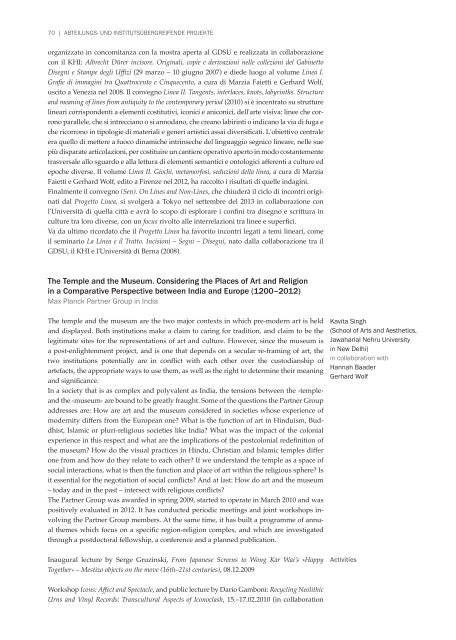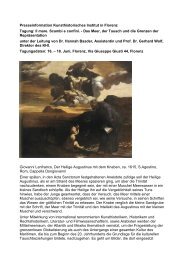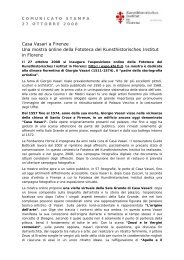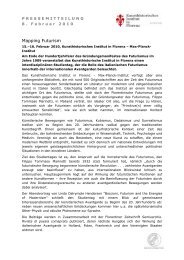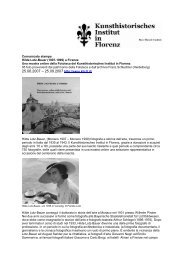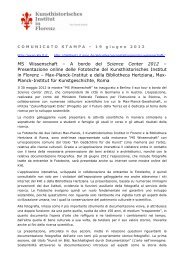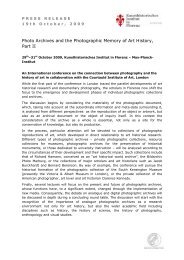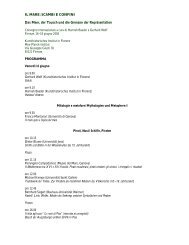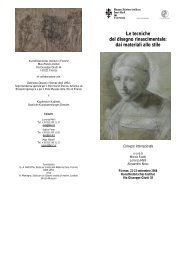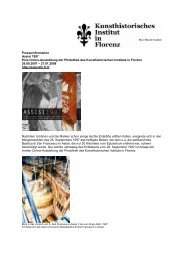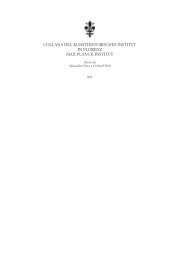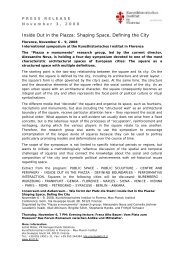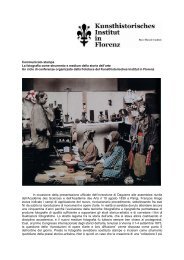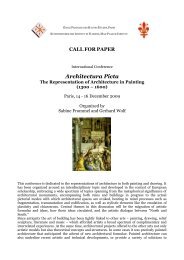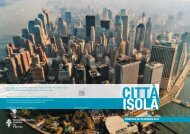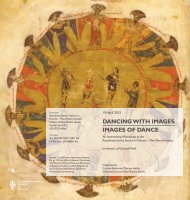forschungsbericht november 2008 – juli 2012 - Kunsthistorisches ...
forschungsbericht november 2008 – juli 2012 - Kunsthistorisches ...
forschungsbericht november 2008 – juli 2012 - Kunsthistorisches ...
Erfolgreiche ePaper selbst erstellen
Machen Sie aus Ihren PDF Publikationen ein blätterbares Flipbook mit unserer einzigartigen Google optimierten e-Paper Software.
70 | ABTEILUNGS- UND INSTITUTSÜBERGREIFENDE PROJEKTE<br />
organizzato in concomitanza con la mostra aperta al GDSU e realizzata in collaborazione<br />
con il KHI: Albrecht Dürer incisore. Originali, copie e derivazioni nelle collezioni del Gabinetto<br />
Disegni e Stampe degli Uffizi (29 marzo <strong>–</strong> 10 giugno 2007) e diede luogo al volume Linea I.<br />
Grafie di immagini tra Quattrocento e Cinquecento, a cura di Marzia Faietti e Gerhard Wolf,<br />
uscito a Venezia nel <strong>2008</strong>. Il convegno Linea II. Tangents, interlaces, knots, labyrinths. Structure<br />
and meaning of lines from antiquity to the contemporary period (2010) si è incentrato su strutture<br />
lineari corrispondenti a elementi costitutivi, iconici e aniconici, dell'arte visiva: linee che corrono<br />
parallele, che si intrecciano o si annodano, che creano labirinti o indicano la via di fuga e<br />
che ricorrono in tipologie di materiali e generi artistici assai diversificati. L'obiettivo centrale<br />
era quello di mettere a fuoco dinamiche intrinseche del linguaggio segnico lineare, nelle sue<br />
più disparate articolazioni, per costituire un cantiere operativo aperto in modo costantemente<br />
trasversale allo sguardo e alla lettura di elementi semantici e ontologici afferenti a culture ed<br />
epoche diverse. Il volume Linea II. Giochi, metamorfosi, seduzioni della linea, a cura di Marzia<br />
Faietti e Gerhard Wolf, edito a Firenze nel <strong>2012</strong>, ha raccolto i risultati di quelle indagini.<br />
Finalmente il convegno (Sen). On Lines and Non-Lines, che chiuderà il ciclo di incontri originati<br />
dal Progetto Linea, si svolgerà a Tokyo nel settembre del 2013 in collaborazione con<br />
l'Università di quella città e avrà lo scopo di esplorare i confini tra disegno e scrittura in<br />
culture tra loro diverse, con un focus rivolto alle interrelazioni tra linee e superfici.<br />
Va da ultimo ricordato che il Progetto Linea ha favorito incontri legati a temi lineari, come<br />
il seminario La Linea e il Tratto. Incisioni <strong>–</strong> Segni <strong>–</strong> Disegni, nato dalla collaborazione tra il<br />
GDSU, il KHI e l'Università di Berna (<strong>2008</strong>).<br />
The Temple and the Museum. Considering the Places of Art and Religion<br />
in a Comparative Perspective between India and Europe (1200<strong>–</strong><strong>2012</strong>)<br />
Max Planck Partner Group in India<br />
The temple and the museum are the two major contexts in which pre-modern art is held<br />
and displayed. Both institutions make a claim to caring for tradition, and claim to be the<br />
legitimate sites for the representations of art and culture. However, since the museum is<br />
a post-enlightenment project, and is one that depends on a secular re-framing of art, the<br />
two institutions potentially are in conflict with each other over the custodianship of<br />
artefacts, the appropriate ways to use them, as well as the right to determine their meaning<br />
and significance.<br />
In a society that is as complex and polyvalent as India, the tensions between the ›temple‹<br />
and the ›museum‹ are bound to be greatly fraught. Some of the questions the Partner Group<br />
addresses are: How are art and the museum considered in societies whose experience of<br />
modernity differs from the European one? What is the function of art in Hinduism, Buddhist,<br />
Islamic or pluri-religious societies like India? What was the impact of the colonial<br />
experience in this respect and what are the implications of the postcolonial redefinition of<br />
the museum? How do the visual practices in Hindu, Christian and Islamic temples differ<br />
one from and how do they relate to each other? If we understand the temple as a space of<br />
social interactions, what is then the function and place of art within the religious sphere? Is<br />
it essential for the negotiation of social conflicts? And at last: How do art and the museum<br />
<strong>–</strong> today and in the past <strong>–</strong> intersect with religious conflicts?<br />
The Partner Group was awarded in spring 2009, started to operate in March 2010 and was<br />
positively evaluated in <strong>2012</strong>. It has conducted periodic meetings and joint workshops involving<br />
the Partner Group members. At the same time, it has built a programme of annual<br />
themes which focus on a specific region-religion complex, and which are investigated<br />
through a postdoctoral fellowship, a conference and a planned publication.<br />
Kavita Singh<br />
(School of Arts and Aesthetics,<br />
Jawaharlal Nehru University<br />
in New Delhi)<br />
in collaboration with<br />
Hannah Baader<br />
Gerhard Wolf<br />
Inaugural lecture by Serge Gruzinski, From Japanese Screens to Wong Kar Wai’s »Happy<br />
Together« <strong>–</strong> Mestizo objects on the move (16th<strong>–</strong>21st centuries), 08.12.2009<br />
Activities<br />
Workshop Icons: Affect and Spectacle, and public lecture by Dario Gamboni: Recycling Neolithic<br />
Urns and Vinyl Records: Transcultural Aspects of Iconoclash, 15.<strong>–</strong>17.02.2010 (in collaboration


